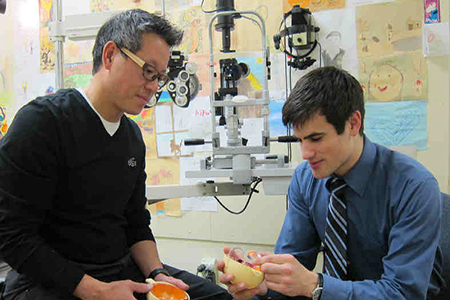You’ve let go of the stereotypes about women not doing traditional “male” jobs and math geniuses breaking the fashion rules with pocket protectors. So why are you still clinging to the idea that engineering is all about building bridges and skyscrapers?
“Engineering is a field that offers its students a vast spectrum of opportunities to change the world. Today’s successful engineer is excited about the chance to bring their intellect and creativity to lead the way for tomorrow’s greatest innovations,” says Kathleen Kramer Director of Engineering Programs at the University of San Diego.
“Students choosing engineering do need to solve problems but those problems aren’t limited to math and science or to just knowing how something works. Now they are also students who want to get to use their interpersonal and creative skills to transform the lives of people across society,” says Kramer.
Engineering students also get to experience good old “rocket science”… updated big time. For example a team of aerospace engineering students from Embry-Riddle Aeronautical University made history when they successfully launched the first two-stage student-designed rocket from NASA’s Wallops Flight Facility in Virginia. (The rocket climbed 37.8 miles — setting an altitude record for a student-built vehicle.) The exercise provided experience directly related to the students’ career aspirations in engineering. Phil Eber, speaker chief of NASA’s Sounding Rockets Program Office noted that “NASA subjects these student rockets to the same scrutiny as a NASA sounding rocket to ensure the flight can be conducted in a safe manner.”
So How Do I Prepare For Engineering While I’m In High School?
Obviously academic preparation is essential to exploring engineering as a career. In high school classes in algebra trigonometry biology physics calculus chemistry computer programming or computer applications can tell you if you have the aptitude and determination to study engineering. While all of these courses are not required to get into every engineering school early preparation can mean the difference between spending four or six years in college. Some universities also require two to three classes in a foreign language for admission. Advanced placement or honors courses always help as do high ACT and SAT scores.
But grades aren’t the only thing that matter. If you think you might be interested in engineering get involved in engineering-related extracurricular activities to not only beef up your college application but also to decide if you enjoy the field. Volunteer intern or apply for a summer job working in a company or for the government (like a police crime lab) where you can observe what different types of engineers do. Don’t be afraid to try a few different things until you find one you like. The possibilities are endless and so are the job opportunities!
What Are The Engineering Classes Like?
Although classes vary from school to school in general students will begin by taking “core” courses and then branch out into specialty classes in later years.
“Students entering our engineering programs start with fundamental courses in math science and basic engineering theory,” explains Douglas J. Goering, Ph.D. P.E. Professor and Interim Dean College of Engineering and Mines at the University of Alaska Fairbanks (UAF). “‘Introduction to Engineering’ is [a] … course that exposes students to a variety of engineering disciplines. Also emphasized are the tools that all engineers need to be successful including technical communication creative design and teamwork. As students progress through the degree programs they have an opportunity to specialize through technical elective courses special projects and undergraduate research. Areas of specialty can vary from institution to institution; at UAF we offer a unique access to the world of arctic and cold regions engineering — a field that is in very high demand these days.”
According to Kettering University President Stan Liberty, today’s best engineering programs get students actively involved in the innovation process well before they graduate. “At Kettering we accomplish this through a modern co-operative education program that integrates learning in a professional work environment with classroom and laboratory learning,” he says. “There are products and processes out there in the not too distant future that we haven’t yet imagined. We in higher education have to prepare our students for jobs that don’t yet exist and to manage processes and design products that haven’t yet been conceptualized.”
At Wentworth Institute of Technology all engineering students participate in the co-op educational program where students work at major companies — like Converse General Electric IBM Lockheed Martin and the Boston Red Sox — while they’re still in school.
“The co-op program provides a solid year of applicable experience,” explains Greg Denon, Director of Career Services at Wentworth. “And 40 percent of Wentworth graduates choose a co-op employer to work for after graduation.”
What Are 3-2 Programs?
Many engineering schools are teaming up with liberal arts colleges to offer 3-2 programs. Simply stated a 3-2 program is an exchange program that allows you to take three years of liberal arts and two years of engineering to earn two degrees: a Bachelor of Arts and Bachelor of Science in Engineering.
Usually a liberal arts school will partner with an engineering school. The student will spend three years at the first school taking all of the foundation classes and then transfer to the second school to complete the engineering portion of the program. The credit earned at the second school transfers back to the first school allowing the student to graduate with two degrees. Not every school offers the 3-2 program so be sure to do your research before deciding on a specific college.
Because of the increased need for engineers with excellent communication and “soft” skills (personal attributes that are measured more in your behavior and attitude than technical talent or education) the 3-2 program is a winning situation for both students and employers.
Another advantage of the 3-2 program is that it allows many students to attend a smaller school with a better faculty student ratio for their first three years of college.
Some schools such as Embry-Riddle Berkeley and Duke also offer 5-year bachelor’s/master’s engineering programs. These are essentially accelerated programs that allow academically strong students to complete two degrees at once.
What Are The Current Trends In Engineering?
With new advances in technology developing daily every facet of engineering is evolving on a regular basis. Perhaps this is most prevalent in biomedical engineering a subcategory in which industry professionals design instruments software and medical devices to help physicians nurses veterinarians therapists and technicians solve complex medical problems and enhance the quality of medical care.
Biomedical engineers have plenty of choices when it comes to specializing including but not limited to:
- Bioinstrumentation: Using computers or electronics to measure diagnose and treat disease
- Biomaterials: Working with living tissue and artificial materials to create implant materials (think artificial organs)
- Cellular tissue and genetic engineering: Finding solutions to disease and illness at the microscopic level
- Orthopaedic bioengineering: Developing artificial joints
- Rehabilitation engineering: Enhancing the capabilities for those with physical and/or cognitive impairments.
Many students say they chose biomedical engineering because it’s people-oriented so it should come as no surprise that according to the American Society for Engineering Education biomedical engineering leads all engineering disciplines in the percentage of degrees awarded to women at all levels — bachelor’s master’s and doctoral.
Another popular field is environmental engineering which is needed both to clean up existing hazards and to prevent new ones. Dr. John Uhran Professor of Computer Science and Engineering at the University of Notre Dame notes that “Because of changes in society we now need to examine carefully how we use our air and water and how we satisfy our demands for energy. We need to explore ways to use energy efficiently and safely and we need to find ways to store it to keep up with the many demands of people worldwide. More than ever engineers are at the forefront of every aspect of keeping today’s and tomorrow’s societies humming at the level that people expect.”
“The many fields of engineering are growing and opportunities abound at this time,” adds Dr. Uhran. “Engineers are involved in a number of fields of study and research both traditional and non-traditional.”
In a time when so many college graduates say their biggest fear is finding a job (and getting out of debt from all their college loans!) it’s comforting to know that the fields of biomedical and environmental engineering have plenty of room for newcomers. According to the Department of Labor employment for biomedical and environmental engineers is expected to grow much faster than average — 27% or more — through 2014. (See chart below for average starting salaries.)
Another hot trend in engineering is mechatronics (mechanics and electronics). In technical terms it’s the “synergistic integration of mechanical electrical and computer systems.” In non-techie terms: You get paid to play with toys!
According to Sharon DeVivo, Vice President of Institutional Relations and Marketing for Vaughn College of Aeronautics and Technology, the college will be offering its first Bachelor of Science engineering program in mechatronics in fall 2007.
“The goal of this program is to provide students with the fundamental knowledge of mechanical and electronic engineering and enable them to design smart engineering components that exhibit precise performance,” she says. “Graduates of this program will acquire knowledge in the areas of mechanical engineering electronics computers controls theory and design processes to create smart and more functional and adaptable products.”
Because most modern gadgets are embedded with electronic control systems mechatronics engineers are involved in the design and construction of almost everything electronic: computers appliances robots anti-lock brakes — you name it!
Human factors engineering is another emerging area that is capturing the interest of many students. The Human Factors program at Embry-Riddle integrates many different disciplines: psychology anthropometrics (the measurement and study of the human body and its capacities) physiology human biological functioning and ergonomics. Human factors professionals work in tandem with the design engineers to develop and refine products and systems for safety greater efficiency and user friendliness.
As you can see the good news is that there are endless possibilities for a career in the field and unless the world suddenly regresses to a pre-Industrial Revolution state they’re just going to increase. The bad news is you might have so much fun at your job that you’ll become a workaholic!
If you’re still not sure what type of engineering fits your personality skills and interests there are opportunities to try your hand at a variety of subcategories before making up your mind.
Whatever your interest — medicine robotics aeronautics design or science — there’s probably an engineering job with your name on it. Of course by the time you graduate from college there could be a whole new subcategory of engineering. You could be working on armies of robots skyscrapers on Mars or even brain transplants.
Who knows? You might one day join the ranks of engineering luminaries like Howard Hughes Bill Gates Donald Douglas (the designer of the C-47 aircraft the workhorse plane of World War II) Lee Iacocca (former president of Ford and former chairman of Chrysler) Patsy Sherman (the inventor of Scotchguard the stain repellant) or Stephanie Louise Kwolek (the inventor of Kevlar the material in bulletproof vests). Well we can’t promise you’ll become a billionaire or the head of a Fortune 500 company … but it’s a start!



